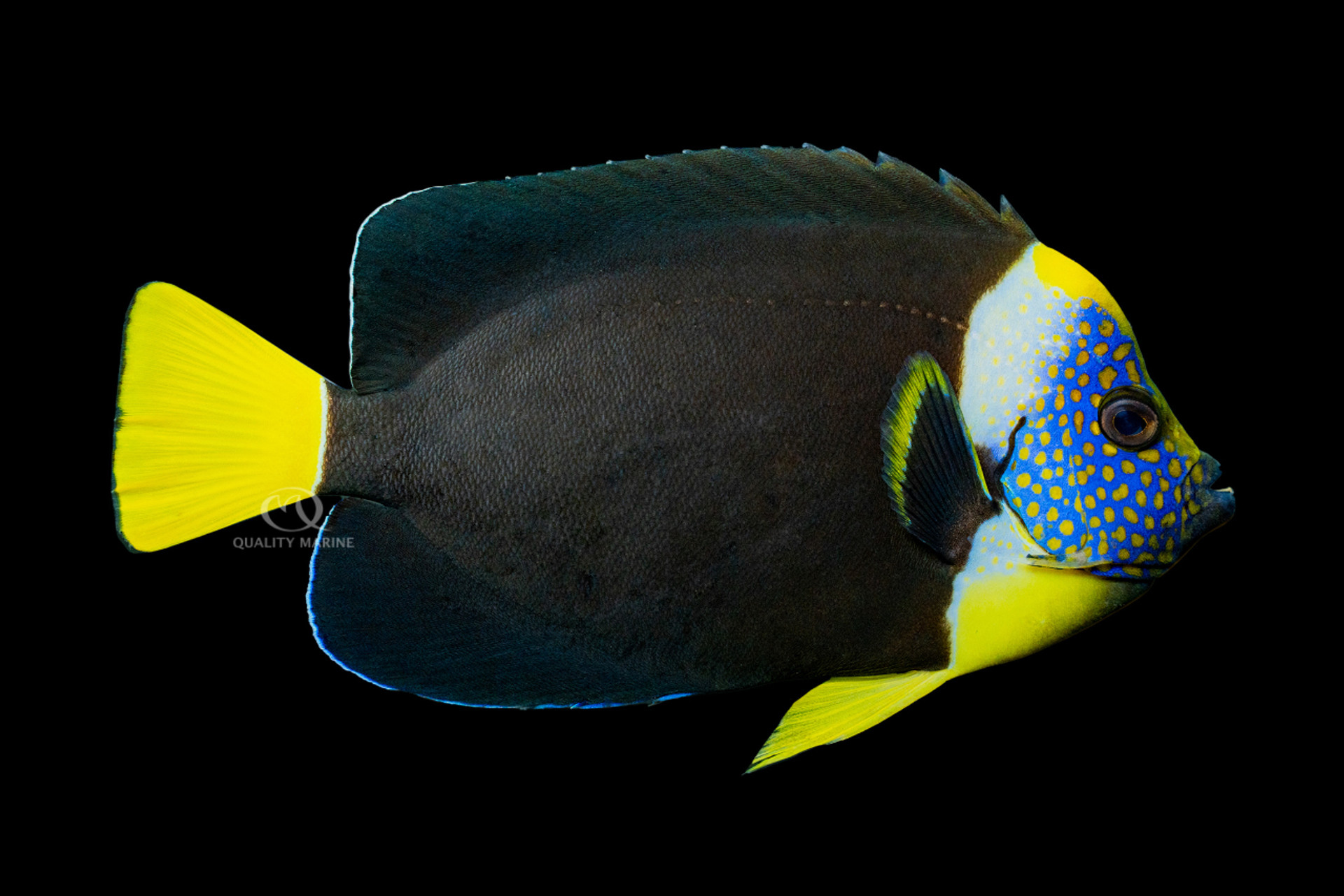What's So False About This Personifer?

What makes an Angel False? Not wanting to wade unprepared into a theological discussion, let's instead discuss the False Personifer Angel, known to scientists as Chaetodontoplus meredithii. To start with, there is really nothing false about it. They are in the same Genus and generally exhibit similar behaviors, liking the same habitats and the same foods as the “real” Personifer (Chaetodontoplus personifer) which gets notably larger, has minor color variations, and comes from the waters off western vs eastern Australia. The “real” Personifer has a bright yellow pectoral fin and their first dorsal fin spine is white, where the False Personifer has a black pectoral fin with a yellow outline and a black first spine on their dorsal fin. Of the two, the False Personifer is the better aquarium fish, and is much more common, hardly reasons to call it “false.”
Even though the False Personifer is smaller than it's “true” cousin, it is still a pretty large aquarium fish, and there are records of them up to about ten inches long. A much more common adult size is in the seven or eight inch range from snout to tail. Between that and its fairly high activity level, it is going to need an aquarium that's at least 180 gallons and six feet long; more wouldn't be amiss. There should be plenty of rocks for the Angel to graze on, swim through and around. They don't care if there is substrate in the display and are good candidates for bare bottom aquariums. They'll love plenty of flow, so you should shoot for 20x turnover or higher (meaning the filters and powerheads should push 20 times the entire tank volume in gallons per hour.) They are generally collected from fairly shallow water and will be mostly accustomed to intense lighting conditions. They can be shy fish initially and so acclimating them to very bright aquariums slowly will help them be more gregarious in their new homes.
False Personifers are relatively peaceful fish, but they can be territorial with other fish that look the same, so we don't recommend keeping multiples unless you have an absolutely massive tank (in the 1000s of gallons) and have a mated pair. In the wild, these fish are usually found by themselves, so this is a very natural way to display them in your aquarium. They can be bullied by overly aggressive fish like lots of the Triggerfish out there and so add your Angel early on in your stocking regimen. They will become bolder over time and could even scare smaller, very timid fish (like Fairy Wrasses and Firefish) into hiding. They'll do well with most middle of the road fish, like nearly all the rest of Wrasses and Groupers, Eels, Lionfish, even lots of smaller fish like Clowns, Damsels, Anthias and Cardinals.
False Personifer Angels will also be okay with most mobile invertebrates like snails, urchins, hermit and other crabs etc, so your cleaning crew won't be in too much peril. They will however take bites out of decorative clams, sea stars, feather dusters, sponges and many/most coral polyps. There are individual exceptions to this rule. Some FPAs will ignore certain corals, or even all of them, but this behavior isn't predictable and can change over time. It's a gorgeous fish to have in an aquarium without corals, but if you want to risk it, start with low-cost corals that can tolerate some nibbling like Anthelia and Xenia.
Water chemistry wise, False Personifers are generally hardy. They are sensitive to bad water quality but will be fine in a variety of different water chemistry levels. A specific gravity between 1.021 and 1.026 is fine as long as it is stable, or changes very slowly. Keep temperatures in the normal tropical range, somewhere between 70 and 78. They are similarly not too attached to any specific pH range, as long as the fluctuations aren't extreme; maintain a value between 7.8 and 8.4 and do your best to limit the day to night change bigger than 0.2.
The one thing about keeping False Personifer Angels that isn't beginner territory is feeding. In part because of their shy nature and in part because of their specific diets in the wild, you need to be really sure they're getting adequate calories and nutrition, especially in the beginning. We feed them three times a day on a diet that includes a variety of food. They are perfect fish for Gamma Cockle in Shell, just break the cockle open a little bit. We also give them Gamma Bloodworms, Mysis, Whole Mussel, Brine Plus Spirulina, Brine Plus Omega 3, Krill Superba and Pacifica. We also offer them Nutramar Nori and/or Ogo once a day. Our secret weapon here for getting them plenty of high-quality protein and the diverse nutrients they need is the Nutramar Algae and Color Boost Shots. These have everything the FPA requires and because we can stick it to rocks or glass in the tank, it allows the Angels to actually graze their food, utilizing their natural feeding triggers. It also helps us get them onto the pellets of the same formula which makes the multiple feeds per day much easier.
The only other real caveat to keeping them (and all big angels) is to avoid using fine meshed nets which can tangle the cheek spines of the False Personifer and injure them. Easy enough. This is one of the Angels in this genus that isn't a giant fish, opening the door to aquarists that don't have room, time or budget for more than a couple hundred gallons of capacity. They are peaceful, beautiful and not actually false in any way. Sound like a fish you need in your tank? Head over to your Local Fish Store and ask them to get you one from Quality Marine! For about five decades now, we've only sold the highest quality fish and inverts, and we hang our hat on that.